A Framework on Analyzing Long-Term Drought Changes and Its Influential Factors Based on the PDSI
Abstract
:1. Introduction
2. Study Site and Data
2.1. Study Site
2.2. Data
3. Methodology
3.1. Wavelet Transform
3.1.1. Continuous Wavelet Transform
3.1.2. Cross-Wavelet Transform
3.2. Mann-Kendall Test
3.3. Assessment of the Relative Rate of Influence
3.3.1. Random Forest and the Relative Rate of Influence
3.3.2. Sliding Time Window
4. Results
4.1. Trend Analysis of Drought
4.2. Periodicity of Drought
4.3. Teleconnections with the Three Influential Factors
4.3.1. Trend Analysis of the Three Influential Factors
4.3.2. Relationship between Drought and the Three Influential Factors
- (a)
- PDSI-sunspot number
- (b)
- PDSI-ENSO
- (c)
- PDSI-PDO
4.3.3. Relative Rates of Influences of the Three Factors
5. Discussion
5.1. Possible Associated Clues between Natural Disasters and Historical Events
5.2. Relationship between Solar Activity, the Little Ice Age, and Drought
5.3. Effect of Large-Scale Atmospheric Circulations on Drought
6. Conclusions
Author Contributions
Funding
Institutional Review Board Statement
Informed Consent Statement
Data Availability Statement
Conflicts of Interest
References
- Brázdil, R.; Dobrovolný, P.; Trnka, M.; Kotyza, O.; Reznickova, L.; Valasek, H.; Zahradnicek, P.; Stepanek, P. Droughts in the Czech Lands, 1090–2012 AD. Clim. Past. 2013, 9, 1985–2002. [Google Scholar] [CrossRef] [Green Version]
- Wang, Z.; Li, J.; Lai, C.; Wang, R.; Chen, X.; Lian, Y. Drying tendency dominating the global grain production area. Glob. Food Secur. 2018, 16, 138–149. [Google Scholar] [CrossRef]
- Lai, C.; Zhong, R.; Wang, Z.; Wu, X.; Chen, X.; Wang, P.; Lian, Y. Monitoring hydrological drought using long-term satellite-based precipitation data. Sci. Total Environ. 2019, 649, 1198–1208. [Google Scholar] [CrossRef] [PubMed]
- Sheffield, J.; Wood, E.; Roderick, M. Little change in global drought over the past 60 years. Nature 2012, 491, 435–438. [Google Scholar] [CrossRef]
- Wang, Z.; Li, J.; Lai, C.; Zeng, Z.; Zhong, R.; Chen, X.; Zhou, X.; Wang, M. Does drought in China show a significant decreasing trend from 1961 to 2009? Sci. Total Environ. 2017, 579, 314–324. [Google Scholar] [CrossRef]
- Wang, Z.; Li, J.; Lai, C.; Huang, Z.; Zhong, R.; Zeng, Z.; Chen, X. Increasing drought has been observed by SPEI_pm in Southwest China during 1962–2012. Theor. Appl. Climatol. 2018, 133, 23–38. [Google Scholar] [CrossRef]
- Lai, C.; Chen, X.; Zhong, R.; Wang, Z. Implication of climate variable selections on the uncertainty of reference crop evapotranspiration projections propagated from climate variables projections under climate change. Agric. Water Manag. 2021, 259, 107273. [Google Scholar] [CrossRef]
- Cook, B.; Smerdon, J.; Seager, R.; Coats, S. Global warming and 21st century drying. Clim. Dyn. 2014, 43, 2607–2627. [Google Scholar] [CrossRef] [Green Version]
- Dai, A.; Wigley, T. Global patterns of Enso-induced precipitation. Geophys. Res. Lett. 2000, 27, 1283–1286. [Google Scholar] [CrossRef] [Green Version]
- Trenberth, K.; Dai, A.; Schrier, G. Global warming and changes in drought. Nat. Clim. Chang. 2013, 4, 17–22. [Google Scholar] [CrossRef]
- Cruger, T.; von Storch, H. Construction of consistent ice core accumulation time series from large-scale meteorological data: Development and description of a regression model for one North Greenland ice core. Clim. Res. 2002, 20, 141–151. [Google Scholar] [CrossRef]
- Watanabe, Y.; Matsuoka, H.; Sakai, S. Comparison of stable isotope time series of stalagmite and meteorological data from West Java, Indonesia. Paleogeogr. Paleoclimatol. Paleoecol. 2010, 293, 90–97. [Google Scholar] [CrossRef]
- Li, J.; Wang, Z.; Lai, C.; Zhang, Z. Tree-ring-width based streamflow reconstruction based on the random forest algorithm for the source region of the Yangtze River, China. Catena 2019, 183, 104216. [Google Scholar] [CrossRef]
- Yang, B.; Chen, X.; He, Y.; Wang, J.; Lai, C. Reconstruction of annual runoff since CE 1557 using tree-ring chronologies in the upper Lancang-Mekong River basin. J. Hydrol. 2019, 569, 771–781. [Google Scholar] [CrossRef]
- Yang, B.; Lai, C.; Chen, X.; Singh, V.; Wang, J. Multi–Proxy Reconstruction of Drought Variability in China during the Past Two Millennia. Water 2022, 14, 858. [Google Scholar] [CrossRef]
- Cook, E.; Woodhouse, C.; Eakin, C.; Meko, D.; Stahle, D. Long-Term aridity changes in the western United States. Science 2004, 306, 1015–1018. [Google Scholar] [CrossRef] [PubMed] [Green Version]
- Cook, E.; Anchukaitis, K.; Buckley, B.; D’Arrigo, R.; Jacoby, G.; Wright, W. Asian monsoon failure and megadrought during the last millennium. Science 2010, 328, 486–489. [Google Scholar] [CrossRef] [Green Version]
- Gou, X.; Gao, L.; Deng, Y.; Chen, F.; Yang, M.; Christopher, S. An 850-year tree-ring-based reconstruction of drought history in the western Qilian Mountains of northwestern China. Int. J. Climatol. 2015, 35, 3308–3319. [Google Scholar] [CrossRef]
- Xu, G.; Liu, X.; Trouet, V.; Treydte, K.; Wu, G.; Chen, T.; Sun, W.; An, W.; Wang, W.; Zeng, X.; et al. Regional drought shifts (1710-2010) in East Central Asia and linkages with atmospheric circulation recorded in tree-ring O-18. Clim. Dyn. 2019, 52, 713–727. [Google Scholar] [CrossRef] [Green Version]
- Bi, Y.; Xu, J.; Gebrekirstos, A.; Guo, L.; Zhao, M.; Liang, E.; Yang, X. Assessing drought variability since 1650 AD from tree-rings on the Jade Dragon Snow Mountain, southwest China. Int. J. Climatol. 2015, 35, 4057–4065. [Google Scholar] [CrossRef]
- Xiao, M.; Zhang, Q.; Singh, V. Influences of ENSO, NAO, IOD and PDO on seasonal precipitation regimes in the Yangtze River basin, China. Int. J. Climatol. 2014, 35, 3556–3567. [Google Scholar] [CrossRef]
- Li, J.; Wang, Z.; Lai, C. Severe drought events inducing large decrease of net primary productivity in mainland China during 1982–2015. Sci. Total Environ. 2020, 703, 135541. [Google Scholar] [CrossRef] [PubMed]
- Jiang, Z.; Lian, Y.; Qin, X. Rocky desertification in Southwest China: Impacts, causes, and restoration. Earth Sci. Rev. 2014, 132, 1–12. [Google Scholar] [CrossRef]
- Dai, A.; Trenberth, K.E.; Qian, T. A global data set of palmer drought severity index for 1870–2002: Relationship with soil moisture and effects of surface warming. J. Hydrometeorol. 2009, 5, 1117–1130. [Google Scholar] [CrossRef]
- Roy, I.; Asikainen, T.; Maliniemi, V.; Mursula, K. Comparing the influence of sunspot activity and geomagnetic activity on winter surface climate. J. Atmos. Sol. Terr. Phys. 2016, 149, 167–179. [Google Scholar] [CrossRef]
- Mauas, P.; Buccino, A.; Flamenco, E. Long-term solar activity influences on South American rivers. J. Atmos. Sol. Terr. Phys. 2010, 73, 377–382. [Google Scholar] [CrossRef] [Green Version]
- Ouyang, R.; Liu, W.; Fu, G.; Liu, C.; Hu, L.; Wang, H. Linkages between ENSO/PDO signals and precipitation, streamflow in China during the last 100 years. Hydrol. Earth Syst. Sci. 2014, 18, 3651–3661. [Google Scholar] [CrossRef] [Green Version]
- Zhang, Q.; Xu, C.; Jiang, T.; Wu, Y. Possible influence of ENSO on annual maximum streamflow of the Yangtze River, China. J. Hydrol. 2007, 333, 265–274. [Google Scholar] [CrossRef]
- Gao, P.; Violette, G.; Temme, A.; Ritsema, C.; Mu, X.; Wang, F. A wavelet analysis of the relationship between Loess Plateau erosion and sunspots. Geoderma 2014, 213, 453–459. [Google Scholar] [CrossRef]
- Torrence, C.; Compo, G. A Practical Guide to Wavelet Analysis. Bull. Amer. Meteorol. Soc. 1998, 79, 61–78. [Google Scholar] [CrossRef] [Green Version]
- Fan, H.; He, D. Temperature and Precipitation Variability and Its Effects on Streamflow in the Upstream Regions of the Lancang–Mekong and Nu–Salween Rivers. J. Hydrometeorol. 2015, 16, 2248–2263. [Google Scholar] [CrossRef]
- Wang, Z.; Lai, C.; Chen, X.; Yang, B.; Zhao, S.; Bai, X. Flood hazard risk assessment model based on random forest. J. Hydrol. 2015, 527, 1130–1141. [Google Scholar] [CrossRef]
- Liu, Y.; Zhao, H. Variable importance-weighted random forests. Quant. Biol. 2017, 5, 338–351. [Google Scholar] [CrossRef] [PubMed] [Green Version]
- Breiman, L. Random Forests. Mach. Learn. 2001, 45, 5–32. [Google Scholar] [CrossRef] [Green Version]
- Rodriguez-Galiano, V.; Chica-Olmo, M.; Chica-Rivas, M. Predictive modelling of gold potential with the integration of multisource information based on random forest: A case study on the Rodalquilar area, Southern Spain. Int. J. Geogr. Inf. Sci. 2014, 28, 1336–1354. [Google Scholar] [CrossRef]
- Larras, F.; Coulaud, R.; Gautreau, E.; Billoir, E.; Rosebery, J.; Usseglio-Polatera, P. Assessing anthropogenic pressures on streams: A random forest approach based on benthic diatom communities. Sci. Total Environ. 2017, 586, 1101–1112. [Google Scholar] [CrossRef]
- Behnamian, A.; Millard, K.; Banks, S.; White, L.; Richardson, M.; Pasher, J. A Systematic Approach for Variable Selection with Random Forests: Achieving Stable Variable Importance Values. IEEE Geosci. Remote Sens. Lett. 2017, 14, 1988–1992. [Google Scholar] [CrossRef] [Green Version]
- Menze, B.; Kelm, B.; Masuch, R.; Himmelreich, U.; Bachert, P.; Petrich, W.; Hamprecht, F. A comparison of random forest and its Gini importance with standard chemometric methods for the feature selection and classification of spectral data. BMC Bioinform. 2009, 10, 213. [Google Scholar] [CrossRef] [Green Version]
- Chen, H.; Tang, G.; Ai, W.; Xu, L.; Cai, K. Use of random forest in FTIR analysis of LDL cholesterol and tri-glycerides for hyperlipidemia. Biotechnol. Prog. 2015, 31, 1693–1702. [Google Scholar] [CrossRef]
- Boulesteix, A.; Bender, A.; Bermejo, J.; Strobl, C. Random forest Gini importance favours SNPs with large minor allele frequency: Impact, sources and recommendations. Brief. Bioinform. 2012, 13, 292–304. [Google Scholar] [CrossRef] [Green Version]
- Fang, T.; Lahdelma, R. Optimization of combined heat and power production with heat storage based on sliding time window method. Appl. Energy. 2016, 162, 723–732. [Google Scholar] [CrossRef]
- Zheng, J.; Xiao, L.; Fang, X.; Hao, Z.; Ge, Q.; Li, B. How climate change impacted the collapse of the Ming dynasty. Clim. Chang. 2014, 127, 169–182. [Google Scholar] [CrossRef]
- Liu, Q.; Li, G.; Kong, D.; Huang, B.; Wang, Y. Climate, disasters, wars and the collapse of the Ming Dynasty. Environ. Earth Sci. 2018, 77, 44. [Google Scholar] [CrossRef]
- Cui, J.; Chang, H.; Burr, G.; Zhao, X.; Jiang, B. Climatic change and the rise of the Manchu from Northeast China during AD 1600-1650. Clim. Chang. 2019, 156, 405–423. [Google Scholar] [CrossRef]
- Fang, K.; Gou, X.; Chen, F.; Davi, N.; Liu, C. Spatiotemporal drought variability for central and eastern Asia over the past seven centuries derived from tree-ring based reconstructions. Quat. Int. 2013, 283, 107–116. [Google Scholar] [CrossRef]
- Wu, L.; Zhou, H.; Zhang, S.; Li, L.; Zhang, M.; Ji, C. Spatial-temporal variations of natural disasters during the Ming & Qing Dynasties (1368-1912AD) in Chaohu Lake Basin, East China. Quat. Int. 2018, 467, 242–250. [Google Scholar]
- De Jager, C. Solar Forcing of Climate. 1: Solar Variability. Space Sci. Rev. 2005, 120, 197–241. [Google Scholar] [CrossRef]
- Wasko, C.; Sharma, A. Effect of solar variability on atmospheric moisture storage. Geophys. Res. Lett. 2009, 36, L03703. [Google Scholar] [CrossRef]
- Stauning, P. Solar activity–climate relations: A different approach. J. Atmos. Sol. Terr. Phys. 2011, 73, 1999–2012. [Google Scholar] [CrossRef]
- Gonçalves, I.; Echer, E.; Frigo, E. Sunspot cycle prediction using Warped Gaussian process regression. Adv. Space Res. 2020, 65, 677–683. [Google Scholar] [CrossRef]
- Roy, I. Climate Variability and Sunspot Activity-Analysis of the Solar Influence on Climate; Springer International Publishing: New York, NY, USA, 2018; ISBN 978-3-319-77107-6. [Google Scholar]
- Gebbie, G.; Huybers, P. The Little Ice Age and 20th-century deep Pacific cooling. Science 2019, 363, 70–74. [Google Scholar] [CrossRef] [Green Version]
- Lamb, H. The cold Little Ice Age climate of about 1550 to 1800. Clim. Present Past Futur. 1972, 1972, 107. [Google Scholar]
- Eddy, J. The Maunder Minimum. Science 1976, 192, 1189–1202. [Google Scholar] [CrossRef] [PubMed] [Green Version]
- Yu, X.; Wang, Y.; Yu, S.; Kang, Z. Synchronous droughts and floods in the Southern Chinese Loess Plateau since 1646 CE in phase with decadal solar activities. Glob. Planet. Chang. 2019, 83, 103033. [Google Scholar] [CrossRef]
- Li, J.; Xie, S.; Cook, E.; Morales, M.; Christie, D.; Johnson, N.; Chen, F.; D’Arrigo, R.; Fowler, A.; Gou, X.; et al. El Niño modulations over the past seven centuries. Nat. Clim. Chang. 2013, 3, 822–826. [Google Scholar] [CrossRef] [Green Version]
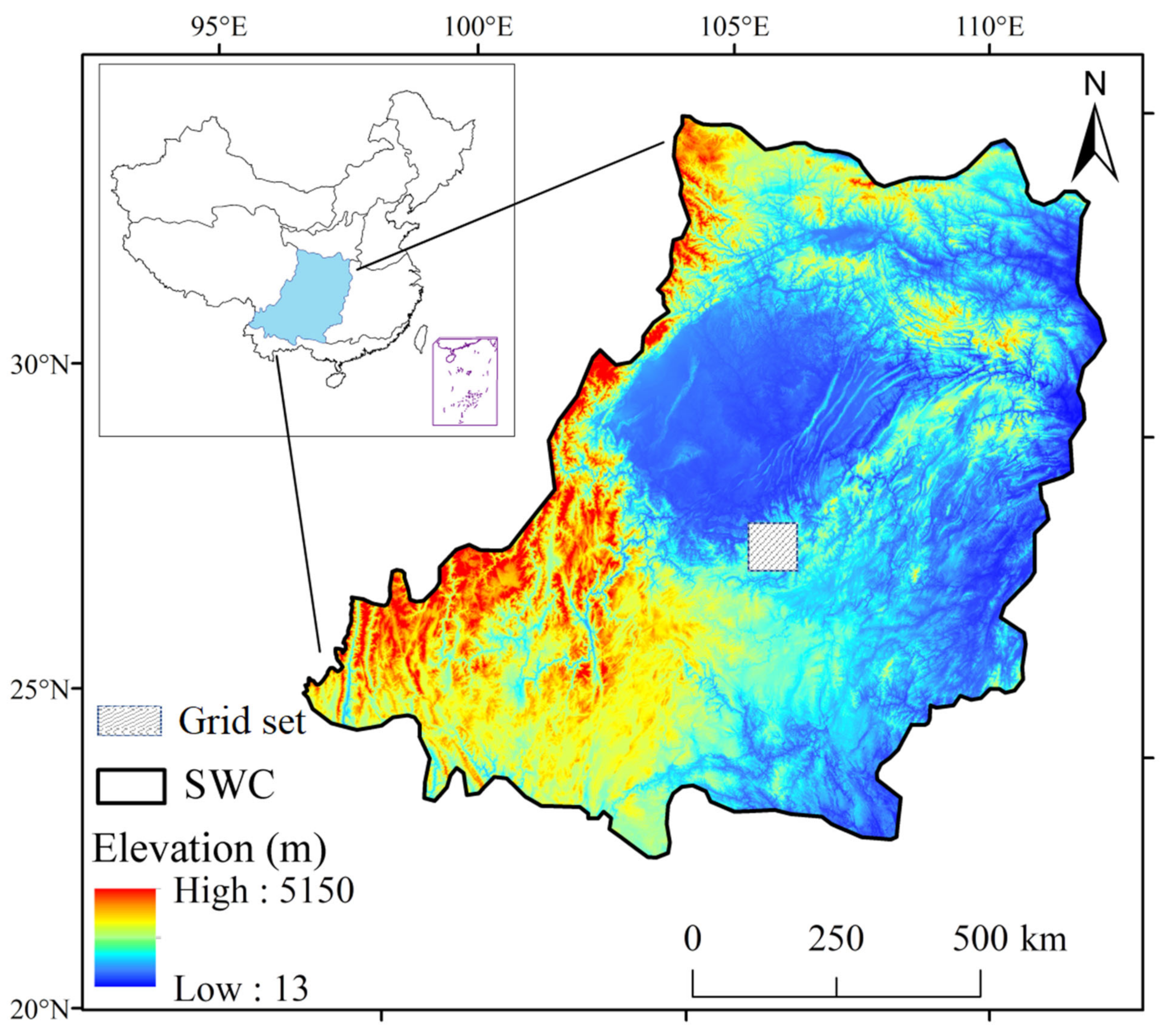

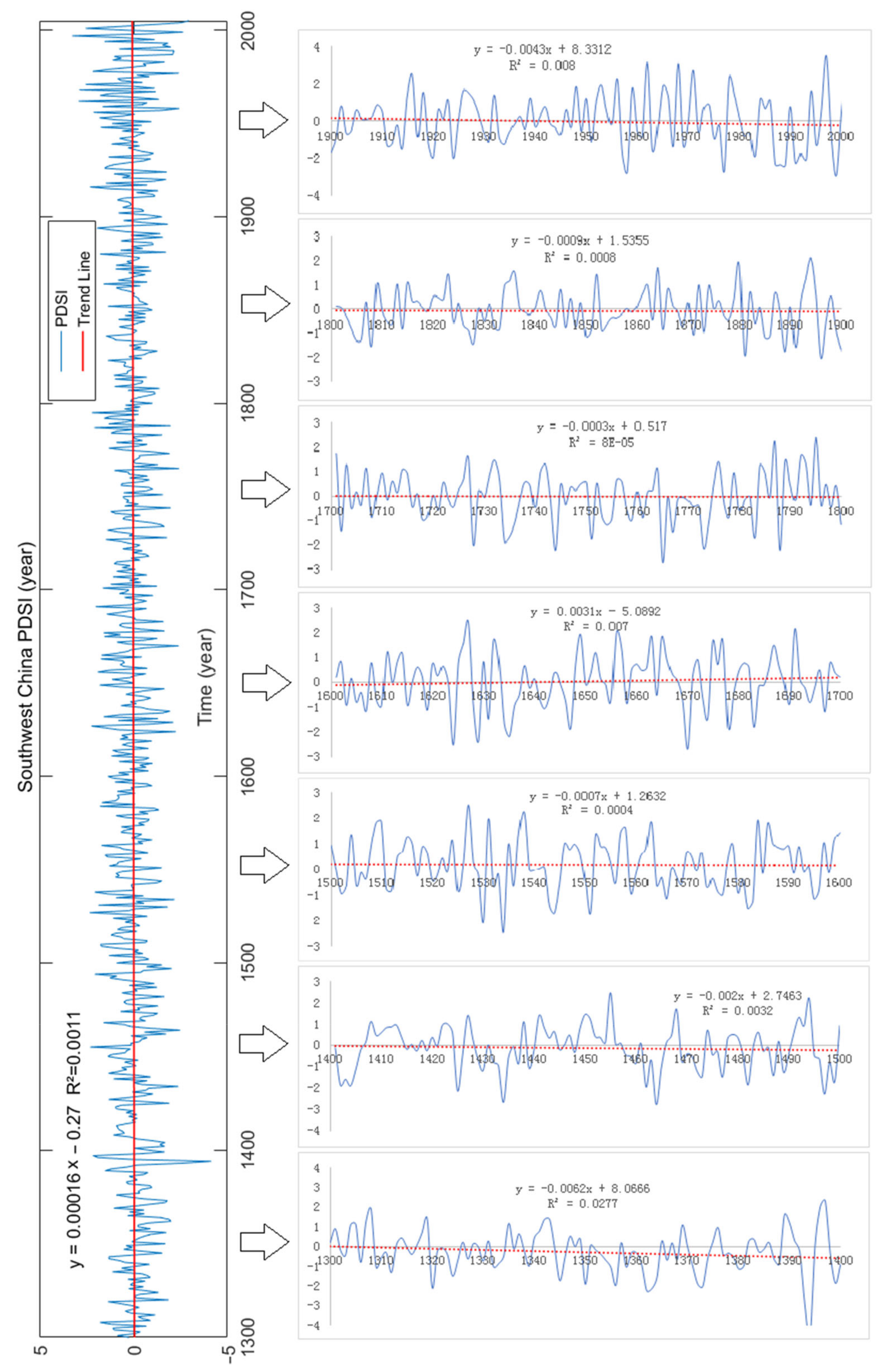
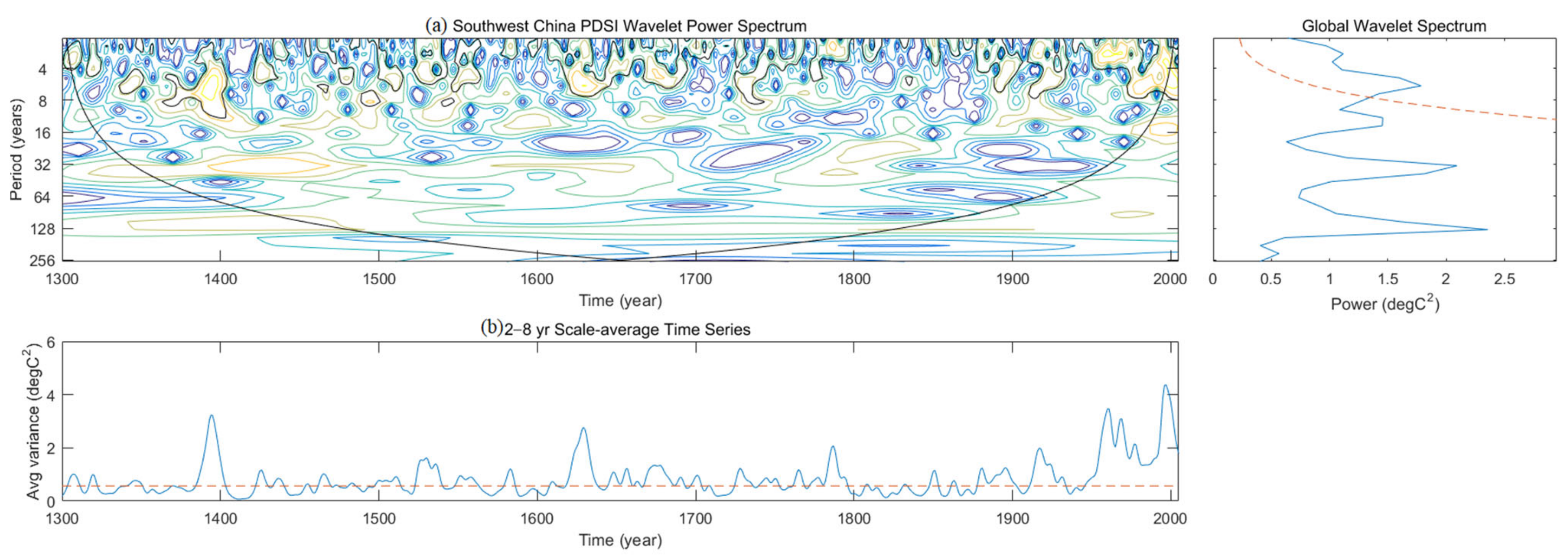
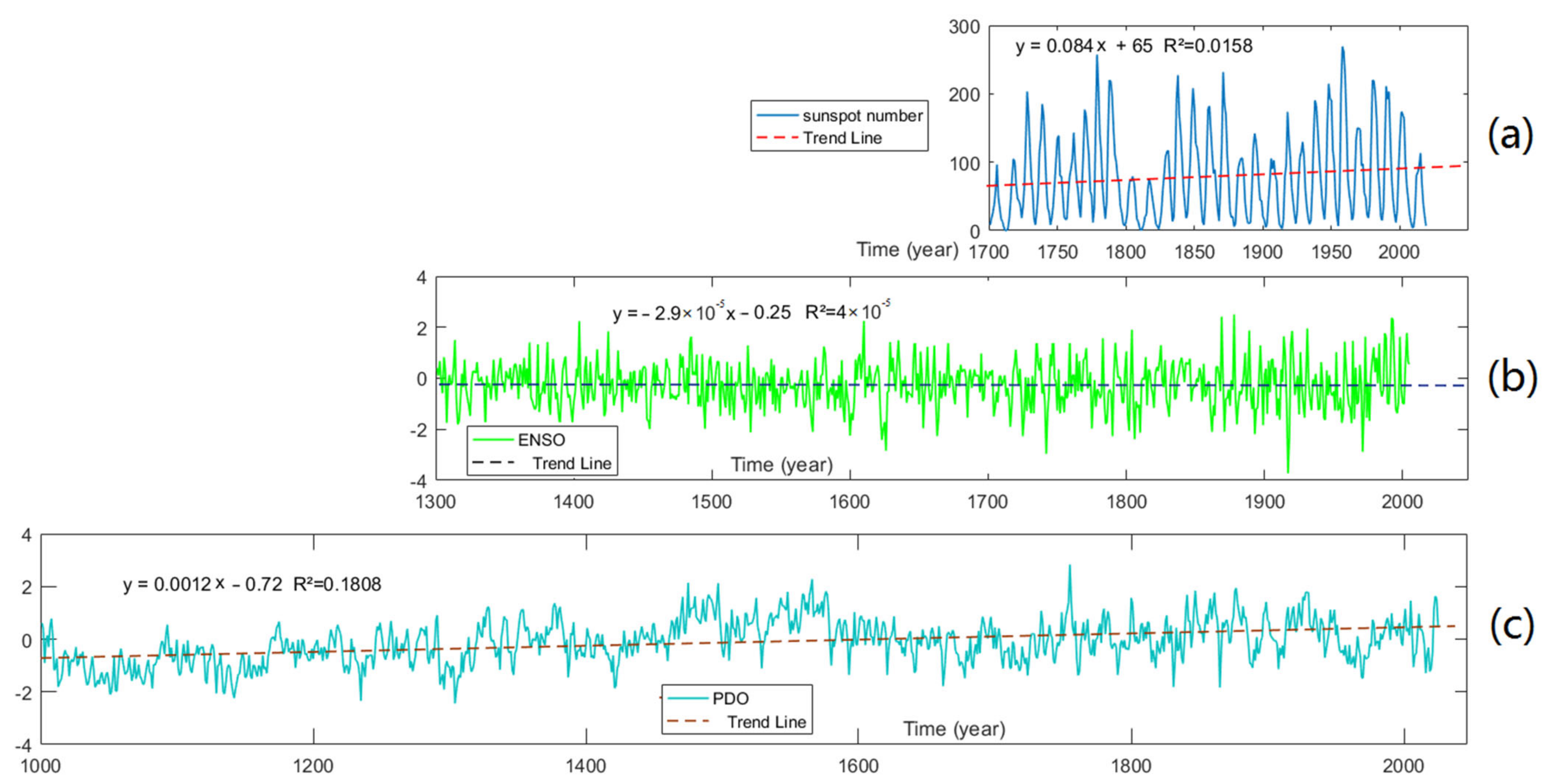

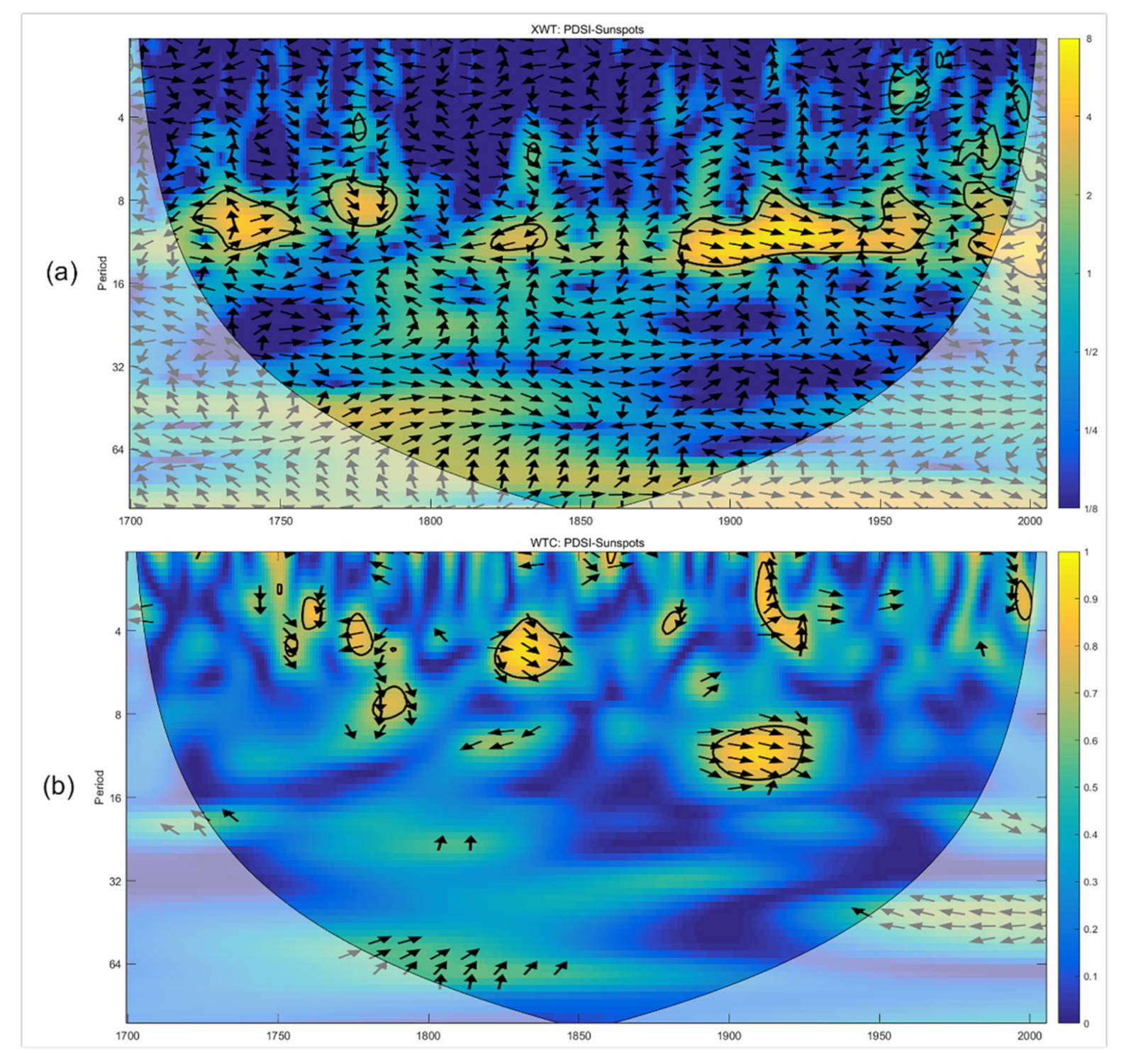


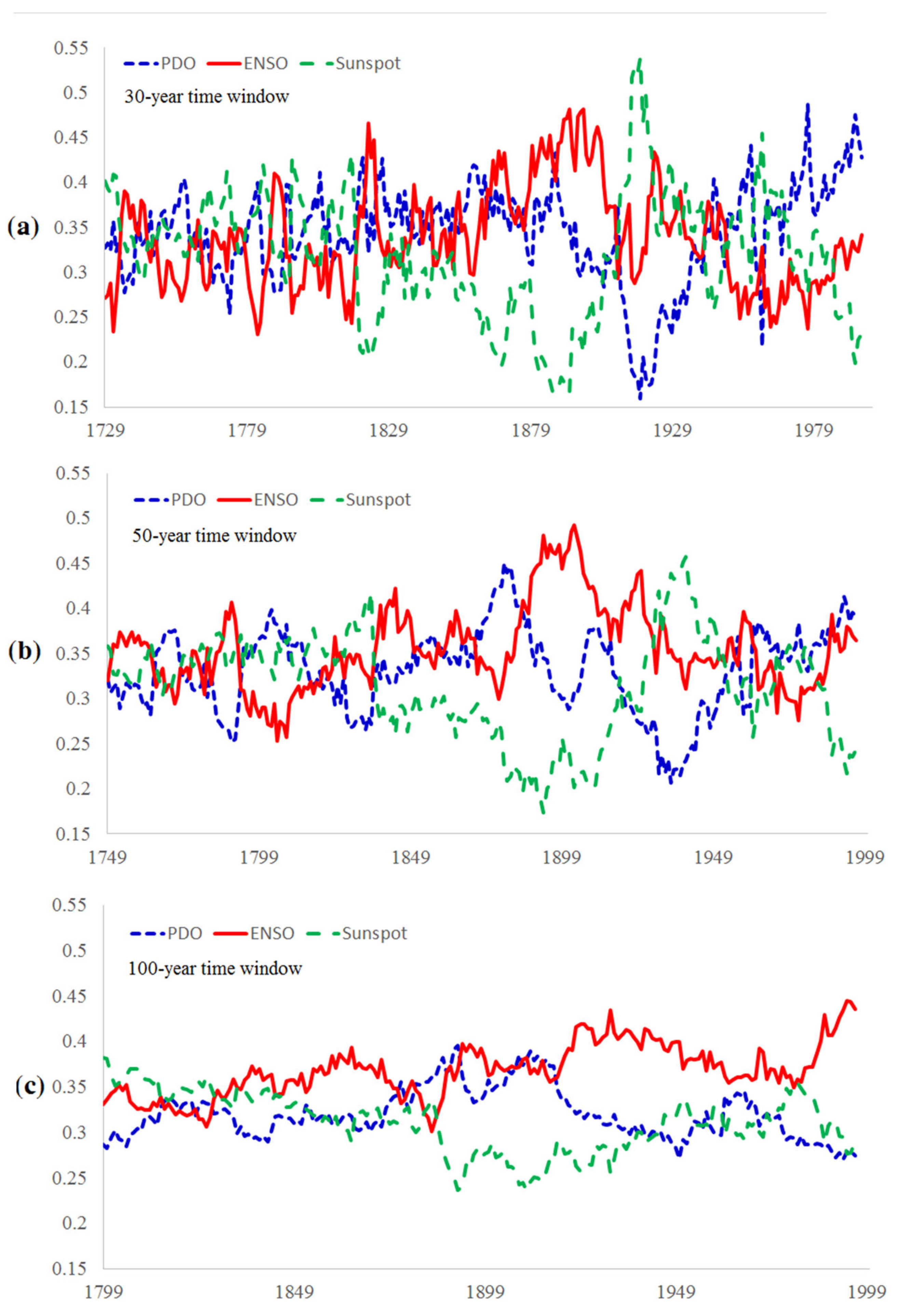
| PDSI Value | Category | PDSI | Category |
|---|---|---|---|
| Above 4.00 | Extreme wet | Below −4.00 | Extreme drought |
| 3.00 to 3.99 | Severe wet | −3.00 to −3.99 | Severe drought |
| 2.00 to 2.99 | Moderate wet | −2.00 to −2.99 | Moderate drought |
| 1.00 to 1.99 | Mild wet | −1.00 to −1.99 | Mild drought |
| 0.50 to 0.99 | Incipient wet | −0.50 to −0.99 | Incipient drought |
| 0.49 to −0.49 | Normal |
| Dynasty | Period (AD)/years | Extreme Drought | Severe Drought | Moderate Drought | Mid Drought | Incipient Drought | Total | Annual Average Frequency |
|---|---|---|---|---|---|---|---|---|
| Yuan | 1300–1368/ 69 | 0 | 0 | 3 | 10 | 12 | 25 | 0.36 |
| Ming | 1368–1644/ 277 | 1 | 0 | 11 | 31 | 46 | 89 | 0.32 |
| Qing | 1644–1911/ 268 | 0 | 0 | 7 | 28 | 44 | 79 | 0.29 |
| The Republic of China | 1912–1949/ 38 | 0 | 0 | 0 | 7 | 5 | 12 | 0.32 |
| The People’s Republic of China | 1949–2005/ 57 | 0 | 1 | 9 | 9 | 8 | 27 | 0.47 |
| All | 1300–2005/ 706 | 0 | 0 | 3 | 10 | 12 | 25 | 0.36 |
Publisher’s Note: MDPI stays neutral with regard to jurisdictional claims in published maps and institutional affiliations. |
© 2022 by the authors. Licensee MDPI, Basel, Switzerland. This article is an open access article distributed under the terms and conditions of the Creative Commons Attribution (CC BY) license (https://creativecommons.org/licenses/by/4.0/).
Share and Cite
Yang, B.; Kong, L.; Lai, C.; Huang, D.; Cheng, X. A Framework on Analyzing Long-Term Drought Changes and Its Influential Factors Based on the PDSI. Atmosphere 2022, 13, 1151. https://doi.org/10.3390/atmos13071151
Yang B, Kong L, Lai C, Huang D, Cheng X. A Framework on Analyzing Long-Term Drought Changes and Its Influential Factors Based on the PDSI. Atmosphere. 2022; 13(7):1151. https://doi.org/10.3390/atmos13071151
Chicago/Turabian StyleYang, Bing, Liang Kong, Chengguang Lai, Dong Huang, and Xiangju Cheng. 2022. "A Framework on Analyzing Long-Term Drought Changes and Its Influential Factors Based on the PDSI" Atmosphere 13, no. 7: 1151. https://doi.org/10.3390/atmos13071151






